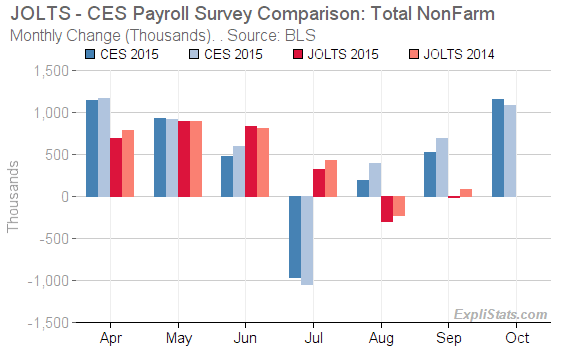
The Job Openings and Labor Turnover Survey from the Bureau of Labor Statistics contains data for Hires and for “Separations” (the latter including all forms of job-holder disappearance.)
The data are monthly time series, and the following equality holds:
Change in Payrolls = Hires minus Separations
This allows us to compare the JOLTS hires and separations with the BLS’s Payrolls Survey (CES).
However, the two surveys do not match up exactly because:
- The Payrolls Survey measures jobs mid-month, whereas the JOLTS hires and separations are for each calendar month, and so give the month-end to month-end change in payrolls.
- The two surveys have different samples of employers. They thus have different biases and seasonalities.
That being said, we can make a rough comparison year-to-year on how each survey tracks the other.
In the chart above, we have Payrolls Survey data in blue, and JOLTS in red. JOLTS has so far only published data to September 2015 whereas we already have October 2015 Payrolls data. (We have not shown October 2015 JOLTS data).
Remember that the JOLTS September change is the change from Aug. 31st to Sep. 30th, while the Payrolls “September” is the change from the week of Aug. 12th to the week of Sep. 12th.
Thus the September JOLTS change captures some of both the September and October Payrolls change.
Observations:
- The latest few months of 2015 have seen weaker growth in both series than in the corresponding months of last year – except for June JOLTS and July Payrolls, and in the October Payrolls, of which so much fuss has been made.
- That October increase in 2015 Payrolls was not presaged by a jump in the 2015 September JOLTS number, published today.
Remember – the October Payrolls growth covers the second half of September. Assuming not to extreme a seasonal difference between the two series, the stronger October Payrolls together with the weaker September JOLTS figure would require the Payrolls boost to have come in the first two weeks of October.
Revisions to the Payrolls Survey have been coming at as much as +/- 50,000, and downward revision to October’s Payrolls in next month’s release would not make enough difference to this picture.
We will just have to wait and see if the November Payrolls, and then JOLTS data support a continued surge, a blip in October, or some random divergence between the two series.
